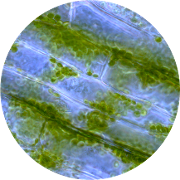Cellular regulatory networks
Cellular regulatory networks

Plastids play a key role in stress perception, for obvious reasons: they harbour some of the most important and most sensitive metabolic processes such as photosynthesis. At the same time, they are intimately connected to the cell’s command centre, the nucleus, as all metabolic reactions in chloroplasts are dependent on both, nuclear-encoded and plastid-encoded genes. Furthermore, the cell has evolved proteins that are located not to one cell compartment, but to two of them. Such dually targeted proteins that are directed to the nucleus as well as to plastids are believed to play a vital role in the communication and coordination between these compartments. The first such protein that was discovered in both compartments of the same plant cell was the Whirly1 protein. Bioinformatic and experimental analyses revealed meanwhile that a larger number of DNA-binding proteins with dual targeting properties exist.
Reverse genetics and the generation of single targeted (partial) mutants are employed to assess the proteins’ roles in regulating gene expression in the two compartments while fluorescent protein tagging technology and biochemical methods are used to unravel the localisation of the proteins and their interaction partners. In addition, the genome of parasitic dodders has revealed which of these proteins has been lost during the evolution of the parasitic lifestyle and which ones are still present.
We are investigating the role of the dually targeted proteins and their regulation in photosynthetic plants versus non-photosynthetic parasitic plants.